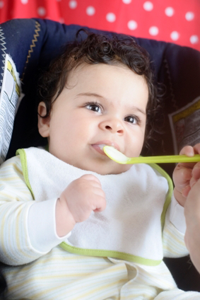Crosswalk to Healthy Beginnings
This activity supports development in relation to the following Healthy Beginnings indicators:
- Personal/Social A1
- Language Development A2
- Cognitive A1, A2, A3
- Physical Development A2
Mealtime Activity: 4-8 Months
 Talk to your baby about what you are doing to get her food ready (e.g., "Mommy is pouring one scoop of cereal. Now Mommy is stirring it."). Give her details about objects in her view, such as, "This spoon is blue and your bib is blue too." While you prepare her food, allow her to play with plastic spoons, small bowls, and/or measuring cups. Place these objects on her highchair tray and see if she will reach for them. Don't be afraid to let her play with her food too! Place a little bit on her tray and allow her to touch and grab for it. This will get her used to different smells, textures, and tastes. Tap her tray with a spoon, and say, "Tap, tap, tap!" See if she will imitate your actions. She may smile, coo, and/or babble when you talk to her, so make sure to "talk" back when she does!
Talk to your baby about what you are doing to get her food ready (e.g., "Mommy is pouring one scoop of cereal. Now Mommy is stirring it."). Give her details about objects in her view, such as, "This spoon is blue and your bib is blue too." While you prepare her food, allow her to play with plastic spoons, small bowls, and/or measuring cups. Place these objects on her highchair tray and see if she will reach for them. Don't be afraid to let her play with her food too! Place a little bit on her tray and allow her to touch and grab for it. This will get her used to different smells, textures, and tastes. Tap her tray with a spoon, and say, "Tap, tap, tap!" See if she will imitate your actions. She may smile, coo, and/or babble when you talk to her, so make sure to "talk" back when she does!
Possible Intervention Strategies & Supports
-
 Hold objects close to your face when naming them to ensure that your baby is attending to both the object and your voice. This will also give additional visual information for helping her to imitate sounds. Be sure to give her a lot of praise when she does imitate, or attempts to imitate, a sound you make!
Hold objects close to your face when naming them to ensure that your baby is attending to both the object and your voice. This will also give additional visual information for helping her to imitate sounds. Be sure to give her a lot of praise when she does imitate, or attempts to imitate, a sound you make!
- In the early months of this stage, be sure to always support your baby in a semi-reclined (not flat) position during feedings. For additional support, you can use rolled up towels tucked next to the sides of her body while in a feeding chair.
- In this age range, try using a Bumbo Seat (see image to right) to get your baby in an upright, supported sitting position (rather than a reclined one). This will help her learn to orient herself in space and use her arms to cross over her body to reach things. Please note that Bumbo Seats are not to be used on high surfaces, such as tables or countertops!
- If your baby can physically hold her bottle but does not, when she removes her hands, allow the bottle to drop. This will help teach her cause and effect.
- You can engage your baby in her feedings by saying things like, "Open up!" or "Ready for more?" and waiting for her to open her mouth in anticipation of the next spoonful before giving it to her. Encourage her to imitate simple sounds, such as "Hmmm" or lip smacking.
Tips
Most babies can be introduced to solids (starting with cereal) at 4 months of age, but just make sure your pediatrician has approved this first. Some pediatricians may want you to wait a little longer. Avoid feeding your baby cereal from a bottle, unless there is a medical reason to do so. It is much more preferable to introduce solids by spoon and use a bottle for liquids. Also, be sure to feed your baby in a supported sitting positioning, meaning that she should be fed in a slightly reclined high chair or in an infant seat. Never flat on her back! When drinking from a bottle, encourage her to help hold it with both hands. Do not enlarge the nipple hole unless directed by your physician or therapy provider to do so.
Family Handout
Click here to download an editable one-page handout of this age range's mealtime activity, interventions, and tips.

